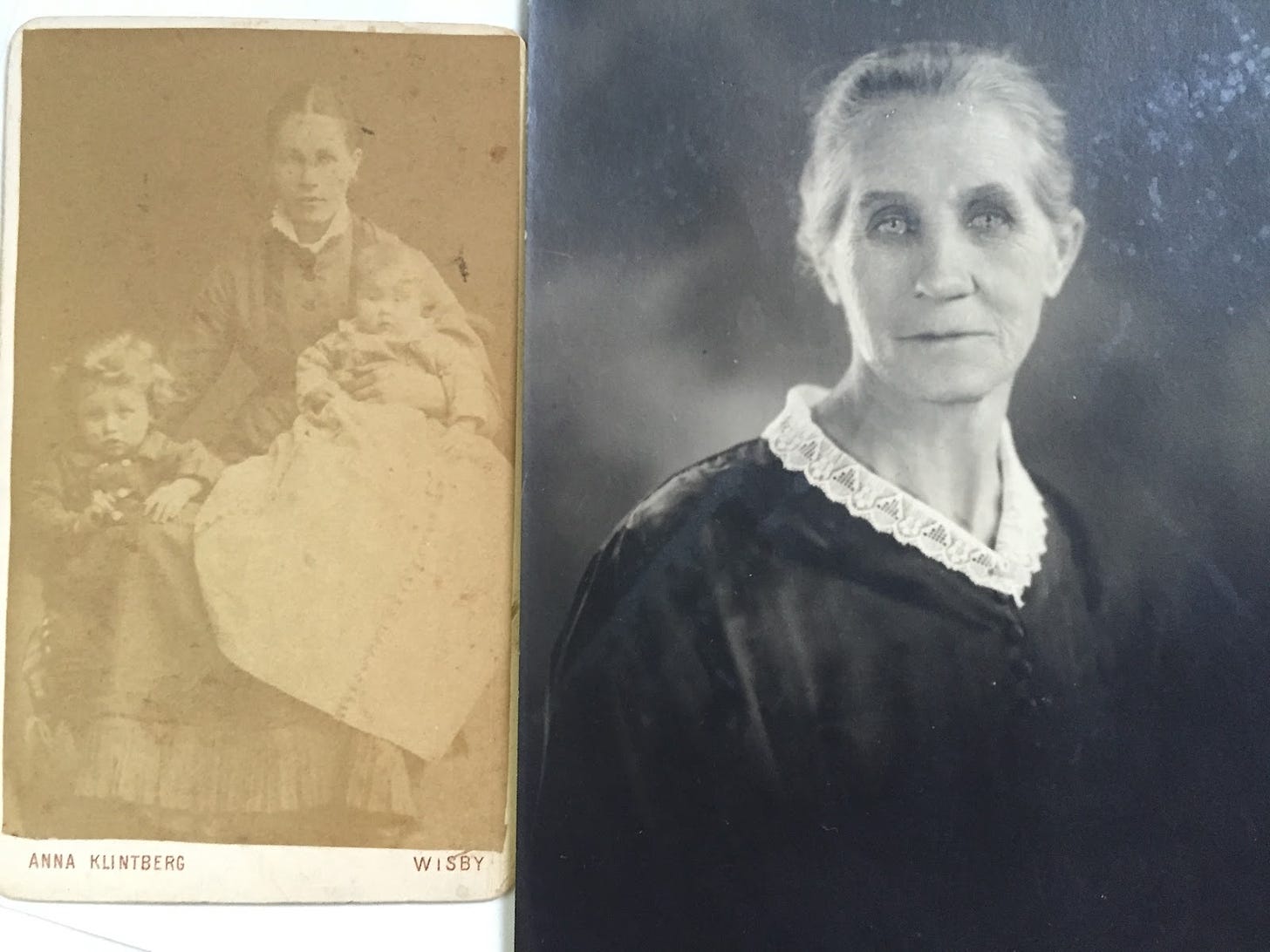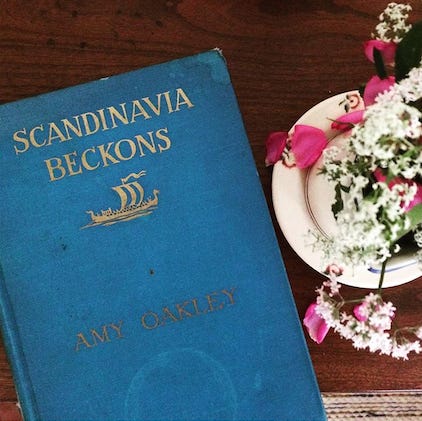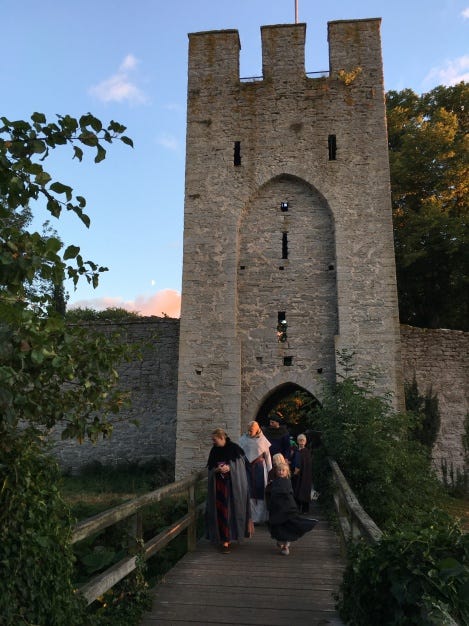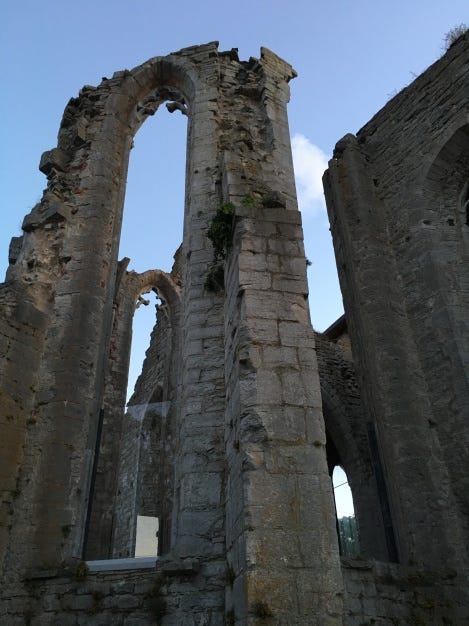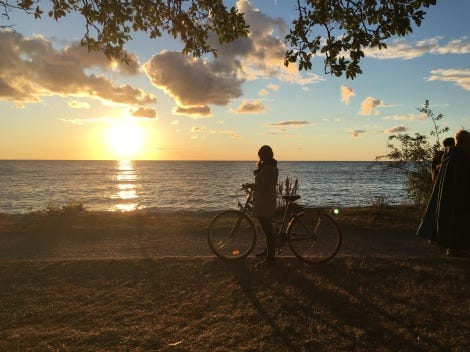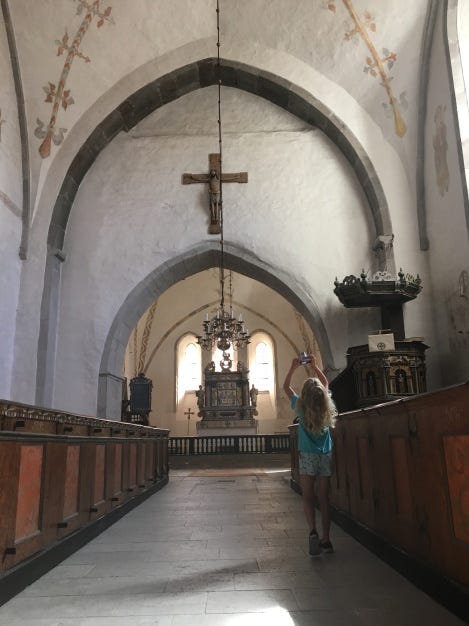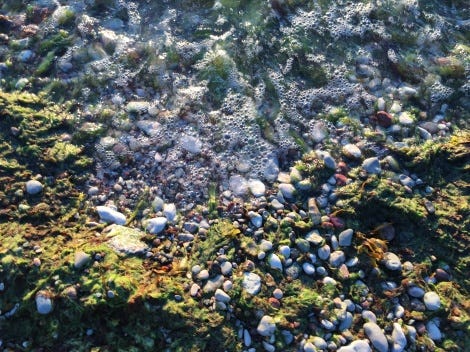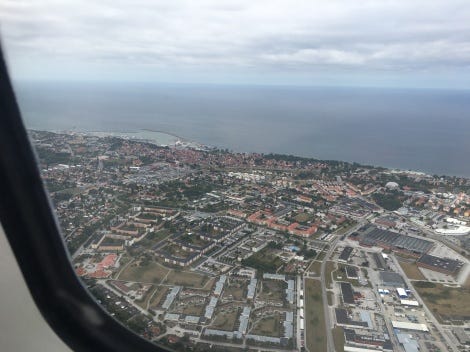Where the Sweden story starts
I didn't think much about my ancestral story until 2016, when my sister and I went to the island our forebears left more than a century before.
When I wrote about Aunt Anna’s ring in last week’s newsletter, I realized that I needed to fill in some gaps in this Sweden story.
When people ask me how I started doing ancestry work, or why I have a random island off the coast of Sweden tattooed on my forearm, this is the story I tell them.
Well, one of the stories I tell.
If you’ve been a subscriber to The Feminist Kitchen for a while, you’ll know that I’m always pulling on these invisible threads with my ancestors to learn more about where I come from. Making quilts, learning Swedish, crying over coffee cake.
This trip to Sweden awakened this part of me. I’m so glad I wrote about it then and that I can share it here now.
After 124 years, Sweden beckons, so here I go
Originally published: Aug 8, 2016
In 1892, my great-great-grandmother got on a boat.
She was 37 years old and had been living on an island in the middle of the Baltic Sea with her two children, in a village not far from where she was born.
By some measures, she was a single mother.
Although Karolina Sofia Andersen was married, she hadn't seen her husband in a decade. He had left Sweden 10 years earlier — while she was pregnant with their second child, Anna — and was living in Springfield, Missouri.
He’s always promised to “send for her,” according to the family story.
Until 2015, I knew absolutely nothing about Sweden or Gotland or Visby. Or Karolina.
But Springfield is a place I know well. I was born there. My mother was born there. My grandmother was born there. My great-grandmother was born there.
But Karolina and Gustav were the generation who would ultimately write the last letter home.
Like so many millions of immigrants to the U.S., she and Gustav were strangers in a foreign land. They didn't speak English when they arrived. They didn't know the customs or the food or the music. I presume they found a church and schools and a community of people like them who were adjusting to this new life.
I make that assumption because they thrived once they reunited. They had four more children, including my great-grandmother.
Karolina had her last child at age 48, and she lived until 1932.
My grandmother was born in 1930.
Those same arms that swaddled her babies in Gotland and even more in Southwest Missouri lived long enough to swaddle one more child.
A baby who, fifty years later, swaddled me.
My grandmother didn't choose to be the keeper of this story. She didn't ask to be the link between these generations. She didn't always love having to repeat the same tale over and over again to kids and grandkids who didn't really care.
Until they did.
A few years ago, my grandmother and I were talking about family history, and this story of our ancestors coming over from Sweden came up.
"Where did you say they were from?" I asked.
"Wisby, but it could be Visby," she replied.
“Let’s look it up on Google maps,” I told her, pulling up my computer.
Suddenly, Where We Came From wasn't some vague region of the planet. It was a specific place right in front of us. An oddly shaped island surrounded by water.
A starting point. A destination. A place I could go.
And so here I am, sitting in an airport, waiting on a flight to Stockholm.
What's waiting for me on the other side? My sister, who is meeting me there. A church outside Visby where Karolina was confirmed. A graveyard where her parents might be buried. A culture we are still trying to retain some kind of connection to. Untold descendants I'll never meet.
A place my ancestors never saw again.
A part of the world that no one in our family has seen in 124 years.
A piece of myself.
Daydreaming about the Swedish homeland (and hedgehogs)
Originally published on Dec 13, 2016.
Four months ago, my sister and I visited Gotland to search for traces for our ancestors, and, if we were lucky, maybe some of those brown, pokey, adorable hedgehogs that roam all over Sweden.
We arrived in the middle of their Medieval Festival, a European Ren Fest, where troupes perform tales, jousters fight on horses and choirs sing traditional songs in church ruins across the city that are so old, the roofs have caved in.
To see 800-year-old church walls standing in the heart of the city was stirring; it was as if the town had doubled as a graveyard for the centuries of history below her cobblestone streets.
I heard stories of a secret tunnel that connected a monastery and an abbey in the center of town. A man named Quest told me what hedgehogs taste like, even though they are "highly illegal" to hunt. The tall costumed Viking from Gothenburg was working the door of a lamb barbecue next to one of those ancient church ruins. His job was to check for swords.
I learned about Gotland's small ponies and ancient burial grounds, Ingmar Bergman's summer house, and a 13th-century wall built, not to ward off invaders from another country, but the farmers who lived in the countryside outside Visby, the largest town on the island.
We covered more than 9,000 years of the island's history at the Gotland Museum, where I spent the majority of time deep in thought about the centuries of amateur historians and curators who preserved the archeological discoveries that they unearthed on this much-used strip of land in the middle of a much-traveled sea. Who decided to start saving this stuff and where was it stockpiled? How on earth do we know what life was like here under Danish rule or the details of a vicious battle in 1250?
The stories of a place like this are strong enough to survive many conquests, it seems.
The history of this island grabs me because it's my history, too.
Before my sister and I started planning this trip, here's what we knew:
My maternal great-great-grandmother — the most maternal: my mom's mom's mom's mom — was born in a small village outside Visby in 1855 and died in Springfield, Missouri in 1932. Before this trip, I didn't know her parents' or siblings' names or the exact location of where she lived on Gotland, but thanks to some detective work on the documents we had — her immigration papers and the first page of the family bible — we nailed down the small villages where she was born and confirmed.
Suddenly, this place where Karolina came from had a pinpoint on a map. We could actually go there.
So we did.
My sister and I started planning this trip earlier this year after my dad's mom passed away. Losing one grandma made us think about our living grandma in a new way. We need to enjoy our time with her and do the things we want to do with her now.
That included bringing alive a story she's heard and has been telling all her life. Even though she thinks she can't remember a thing, Gaga recalled so many of the details: That Karolina and Gustav came to the U.S. 10 years apart, and that when he left, Karolina was pregnant with their second child. That they had four more kids after she and the older kids, Frederick and Anna, finally reunited with Gustav in Springfield. (My grandmother was born in that same city a mere 38 years after their arrival and now lives in a small town about 30 miles away.)
When Karolina, a single mother for a decade, packed up her belongings, her children, and her courage, she sailed away from her family and homeland for the last time.
More than 120 years later, my sister and I sat on a plane and peered through the window at the fields and trees and roads and shoreline of Gotland. The land would have been so familiar to my ancestors.
I felt what I can only describe as a lightning bolt of ancestral connection. Familiarity.
It wasn't until this trip that I uncovered even more details about the family she left behind. I found out that her mother died when Karolina was 19. Her father remarried and had another family. Even though I had even more pieces of the puzzle, I wasn't able to track down any of Karolina's living relatives. One thing struck me when I looked at all their birth and death dates on Ancestry.com: It appears that all of them died in Sweden.
Karolina is buried in a cemetery in Springfield, Mo., a long long long long long way from Sweden.
I wonder how much she thought about the sunset over the water. The sound of her sisters’ voices. And those hedgehogs I never found.
More Swedish-American stories from The Feminist Kitchen archives:



